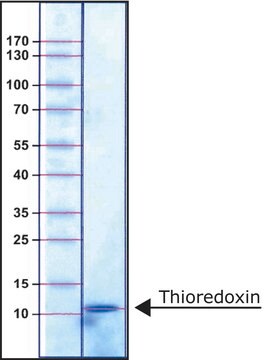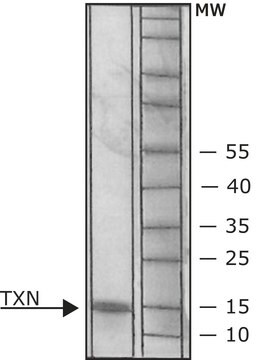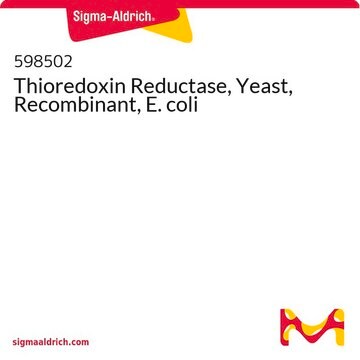T9698
Thioredoxin Reductase from rat liver
buffered aqueous glycerol solution, ≥100 units/mg protein (Bradford)
Synonyme(s) :
NADPH:Oxidised Thioredoxin Oxidoreductase, Thioredoxin: NADP+ Oxidoreductase
About This Item
Produits recommandés
Source biologique
rat liver
Niveau de qualité
Essai
≥90% (GE)
Forme
buffered aqueous glycerol solution
Activité spécifique
≥100 units/mg protein (Bradford)
Poids mol.
55—67 kDa
Technique(s)
activity assay: suitable
Impuretés
Glutathione reductase
Solubilité
water: soluble
Adéquation
suitable for molecular biology
Numéro d'accès UniProt
Conditions d'expédition
dry ice
Température de stockage
−20°C
Informations sur le gène
rat ... Txnrd1(58819)
Description générale
Application
Actions biochimiques/physiologiques
Définition de l'unité
Forme physique
Code de la classe de stockage
12 - Non Combustible Liquids
Classe de danger pour l'eau (WGK)
WGK 1
Point d'éclair (°F)
Not applicable
Point d'éclair (°C)
Not applicable
Équipement de protection individuelle
Eyeshields, Gloves, multi-purpose combination respirator cartridge (US)
Faites votre choix parmi les versions les plus récentes :
Déjà en possession de ce produit ?
Retrouvez la documentation relative aux produits que vous avez récemment achetés dans la Bibliothèque de documents.
Les clients ont également consulté
Articles
Oxidative stress is mediated, in part, by reactive oxygen species produced by multiple cellular processes and controlled by cellular antioxidant mechanisms such as enzymatic scavengers or antioxidant modulators. Free radicals, such as reactive oxygen species, cause cellular damage via cellular.
Notre équipe de scientifiques dispose d'une expérience dans tous les secteurs de la recherche, notamment en sciences de la vie, science des matériaux, synthèse chimique, chromatographie, analyse et dans de nombreux autres domaines..
Contacter notre Service technique










